mulch film price
Mulch film price represents a crucial consideration in modern agricultural economics, reflecting the intersection of quality, functionality, and cost-effectiveness in farming operations. These specialized agricultural films typically range from $100 to $300 per acre, depending on thickness, material composition, and technical specifications. The pricing structure encompasses various factors including UV protection capabilities, degradability options, and seasonal durability. Standard mulch films are manufactured using premium-grade polyethylene materials, offering thickness options from 0.8 to 1.5 mils, making them suitable for different crop types and growing conditions. The price point often correlates with enhanced features such as temperature regulation, moisture retention, and weed suppression capabilities. Manufacturers today offer diverse pricing tiers, accommodating both small-scale farmers and large agricultural operations. The cost analysis must consider the film's lifespan, which typically spans one growing season, though premium variants may last longer. Modern mulch films incorporate advanced technologies for improved soil temperature management and water conservation, features that justify their price positioning in the agricultural supplies market.


